|

University Hall (Old Main) 1908
As previously indicated, the University was established in 1897. The inital study body
consisted of 42 students.
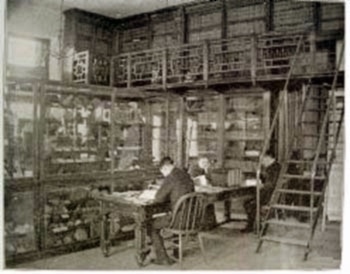 Library interior, approx. 1895
Library interior, approx. 1895
Tuition was free for those nominated by their respective Boards of County Commissioners. Out-of-state tuition
was $5.00. There was a library fee of $2.50. Boarding was available with respectable families for about $25.00 a month or
the faculty would assist students who wished to rent their own dwellings or apartments.
Dr. Grace Raymond Hebard described the University when she first arrived, as
a vacant lot more actually speaking, with a single, isolated, substantial building
surrounded by the perpetually snow capped mountains of the Medicine Bow Range.
The campus was without fence, without walks, or trees, shrubs, lawn, grass, or evidence of
flowers during the past season * * * .
The "library," according to Dr. Hebard, was hardly better, consisting of
a room without table, chair, desk, shelves, book-case, blackboard, curtain, only
three sacks of Government books piled in a pyramid in the center of the floor.
Dr. Hebard's description was perhaps exagerated, but not much. The library was started with a
contribution from Charles Clay of 300 books. Today, the library has some 1.5 million catalogued
volumes, over a million government documents, 167,000 maps, and adds some 24,000 new volumes each year.
Dr. Hebard served as the University's third librarian, taking the helm
in 1894. Members of the faculty were expected to fill multiple functions. Dr. Hebard, as an example, was a professor, Secretary to the
Board of Trustees, and librarian all at the same time. Her predecessor as librarian, Justus F. Soule (1861-1939) also served as
Professor of Greek and Latin and football coach. The intitial five football seasons, 1893 - 1897, under Coaches
Soule and Fred Hess, were a winning ones with no losses. The season records:
|
Year |
W | L |
T |
|
1893 |
1 | 0 |
0 |
|
1894 |
3 | 0 |
0 |
|
1895 |
1 | 0 |
0 |
|
1896 |
2 | 0 |
0 |
|
1897 |
2 | 0 |
0 |
The following years were not kind. Under Coach Hess in 1898, the team lost all four games. Under Coach
Soule in 1899, the team lost one and tied one. That year, however, saw the beginning of the "Border Wars" with
Colorado Agricultural College (now known as Colorado State University), the oldest rivalry in the
Mountain West. Coach Soule continued as coach through the 1899 season and Hess through 1898.
In 1938, Wyoming became a member of the Skyline Conference; in 1962, the Western Athletic Conference; and in 1999, the Mountain West. In post-season
play, Wyoming has played in the Gator, Sun, Sugar, Fiesta, Holiday, Copper, and Las Vegas Bowls.
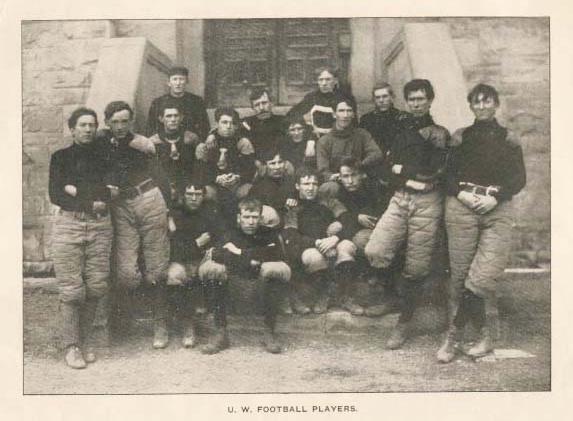
1900 University of Wyoming Football Team
The team appears to be sitting on the front steps of
Old Main. Editor Hayford also expressed his opinion as to football:
We are not familiar enough with the game to give any technical
or detailed report of it. It looks to a man up a tree like a rough and
tumble Donnybrook fair fight minus the shallalas. Several of the participants were
more or less hurt and carried off the field.
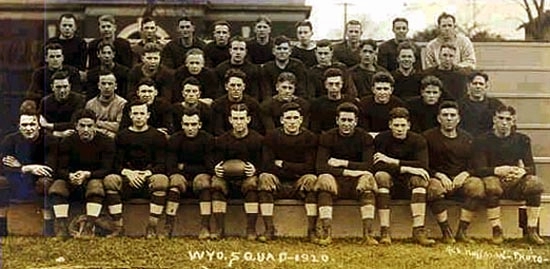
1920 University of Wyoming Football Team
During the 1920 Season under Coach John Corbett, Wyoming was 4-5-1. Coach Corbett served from
1915 through 1923.
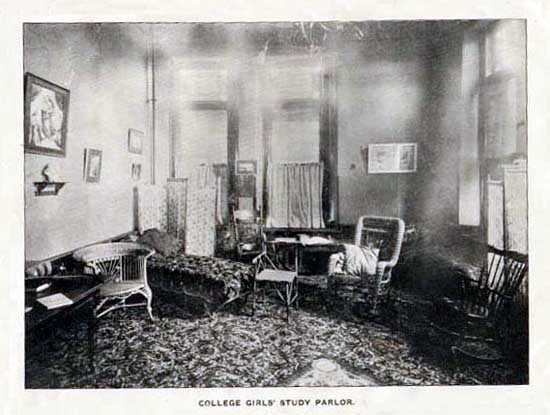
Women's Study Parlor, University of Wyoming, 1900.
Commencing in 1922 the University began a program of expansion including the construction of a number
of building fronting on the Pasture including Half Acre Gym, Engineering, Arts and Sciences and
Agriculture.
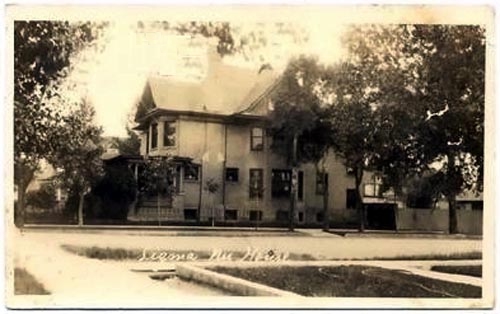
Epsilon Delta Chapter, Sigma Nu Fraternity, University of Wyoming, 1920's.
Photo by H. Svenson.
Sigma Nu was chartered at the University of Wyoming in 1920. Other fraternities presently on campus are Sigma Alpha
Epsilon ("SAE") chartered in 1917, Alpha Gamma Rho, Alpha Tau Omera, Lambda Chi Alpha, Pi Kappa Alpha, Sigma Chi, and
Sigma Phi Epsilon. SAE is the oldest fraternity on campus tracing its history to a
local fraternity Sigma Beta Phi established in 1903. Sororities are Chi Omega, Delta Delta Delta, Kappa Kappa Gamma, and Pi Beta Phi.
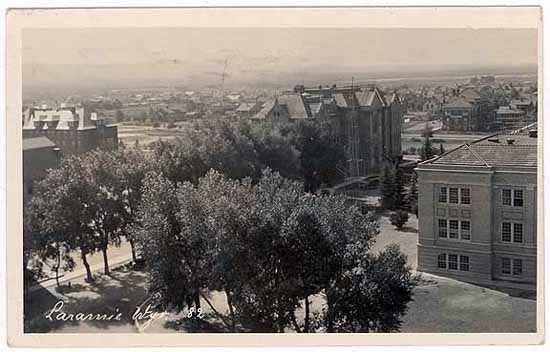
University of Wyoming, 1925. Photo by H. Svenson.
Many universities have an open area in the center of the campus known as the "Quad" or Quadrangle. The
University of Wyoming does not have a quad. Instead, in the center of the campus is an open area known as the
"Pasture" or "Prexy's Pasture." Other universities, such as one of the writer's own
alma maters, with limited space for growth have given into the temptation
to construct buildings in the "quad." In 1965, a proposal was put forth to construct a
12-story building in a portion of the Pasture. As a result of the hue and cry that the
proposal created, Prexy's Pasture is protected from such
depredations. Any construction would require the specific approval of the
State Legislature. Section 21-17-401, Wyoming Statutes, provides:
(b) In order to preserve the natural and open beauty of that portion of
the University of Wyoming campus commonly known and referred to as "Prexy's
Pasture", no structures, other than ornamental improvements, or buildings
of any kind or type shall be located or constructed upon the portion of the
campus described as follows:
(i) All that portion of the East 1/2 of Section 33, Township 16 N, R 73 W,
of the 6th PM, Albany county, Wyoming, bounded as follows:
(A) Beginning at a point from which the East 1/4 corner of said Section
33 bears, South 83 degrees 15' East a distance of 803 feet; thence South 5
degrees 45' West a distance of 410 feet; thence North 84 degrees 15' West a
distance of 578 feet; thence North 5 degrees 45' East a distance of 410
feet; thence North 84 degrees 15' East a distance of 578 feet, more or
less, to the point of beginning. Said parcel of land containing 5.44
acres, more or less.
In 2004, Prexy's Pasture was renovated. The old mugho pines and some of the
Blue Spruce were removed and replaced with new trees. Allegedly, the Pasture
received its name as an area where students could pasture their horses while attending
class.
For "PastureCam" Click Here. Use
browser back button to return.
Music this Page, the University fight song, Ragtime Cowboy Joe:
RAGTIME COWBOY JOE
He always sings
Raggy music to the cattle
as he swings
back and forward in the saddle,
on a horse - a pretty good horse!
He's got a syncopated gaiter,
and you ought to hear the meter
to the roar of his repeater;
how they run - yes run! -
when they hear him 'a-comin',
cause the western folks all know,
he's a high-falootin', rootin, tootin',
son of a gun from ol' Wyoming,
Ragtime Cowboy
Talk about your Cowboy,
Ragtime Cowboy Joe.
Laramie Photos continue on next page.
|